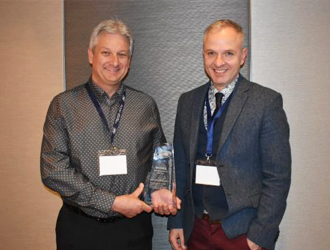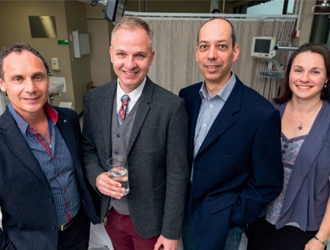
North Eastern Community Hospital wins award for their work on implementing Ecas4 technology
<h6>Announcement</h6><!-- [et_pb_line_break_holder] --><!-- [et_pb_line_break_holder] --><h1 style="color: #00b1bf;"><span class="slider-header-bold" style="color: #00b1bf;">North Eastern Community Hospital wins award for their work on implementing Ecas4 technology</h1><!-- [et_pb_line_break_holder] --><!-- [et_pb_line_break_holder] --><img class="blog-image" src="https://www.ecas4.com.au/wp-content/uploads/2017/10/North-Eastern-Community-Hospital-award-702x336.jpg"><p class="image-caption" style="text-align: left;"><span class="image-caption-header">Left to right:</span> Daniel Walker, Maintenance Manager, and Scott Williams, CEO, accepting the Non-Clinical Service Delivery award.</p><!-- [et_pb_line_break_holder] --><!-- [et_pb_line_break_holder] --><p class="blog-subhead">Water purification project wins top award</p><!-- [et_pb_line_break_holder] --><!-- [et_pb_line_break_holder] --><p>An Adelaide hospital has been hailed as an innovator for delivering clean and safe chemical-free water at the Australian Council on Healthcare Standards (ACHS) Quality Improvement Awards.</p><!-- [et_pb_line_break_holder] --><!-- [et_pb_line_break_holder] --><p>The North Eastern Community Hospital (NECH) recently won the Non-Clinical Service Delivery Award for their work on implementing the Ecas4 electrochemical water treatment system in their hospital, which has resulted in improvements in sterilisation and significant cost savings for the hospital.</p><!-- [et_pb_line_break_holder] --><!-- [et_pb_line_break_holder] --><p>NECH Chief Executive Officer, Scott Williams said it was humbling to receive such a celebrated national award and thanked ACHS for the recognition.</p><!-- [et_pb_line_break_holder] --><!-- [et_pb_line_break_holder] --><p>“As a not-for-profit hospital and aged care facility, we’ll never be the biggest but that doesn’t stop us from constantly striving to be the very best when it comes to patient and resident safety and care,” said Mr Williams.</p><!-- [et_pb_line_break_holder] --><!-- [et_pb_line_break_holder] --><p>Mr Williams also thanked his colleagues at the hospital and external partners in the project, Ecas4 Australia Director Antony Amorico and his team and the University of South Australia Associate Professor Erica Donner and her assistants.</p><!-- [et_pb_line_break_holder] --><!-- [et_pb_line_break_holder] --><p>“It was this commitment and dedication of all involved that ultimately provided our organisation and all associated with it, the safest and cleanest water anywhere in the country’s health care sector,” Mr Williams said.</p><!-- [et_pb_line_break_holder] --><!-- [et_pb_line_break_holder] --><p>ACHS Executive Director of Customer Services and Development Linda O’Connor, said NECH’s submission clearly demonstrated the hospital’s leadership status as an innovator in its sector.</p><!-- [et_pb_line_break_holder] --><!-- [et_pb_line_break_holder] --><p>“North Eastern Community Hospital’s ground breaking project, backed by independently verified results, challenges standard practices through creative problem-solving to not only improve the quality of its water, but to do so in an environmentally sensitive and cost-effective manner,” said Ms O’Connor.</p><!-- [et_pb_line_break_holder] --><!-- [et_pb_line_break_holder] --><p>Mr Williams said the hospitals philosophy of constant improvement drove them to team up with Ecas4 to become the first hospital in Australia to implement its Anolyte technology.</p><!-- [et_pb_line_break_holder] --><!-- [et_pb_line_break_holder] --><p>“The system produces a highly effective pH neutral, electrochemically active and metastable disinfectant without the use of toxic chemical to control Legionella in the water pipelines,” said Mr Williams.</p><!-- [et_pb_line_break_holder] --><!-- [et_pb_line_break_holder] --><p>Mr Williams added that as the Ecas4 system is now in the hospital’s system, the next step is to explore the possibility of removing the use of everyday chemicals from NECH’s cleaning operations, starting with the food preparation area.</p><!-- [et_pb_line_break_holder] --><!-- [et_pb_line_break_holder] --><p>“The long terms goal is to use this technology to sterilise other NECH facilities such as waiting areas and hospital rooms post discharge,” said Mr Williams.</p><!-- [et_pb_line_break_holder] --><!-- [et_pb_line_break_holder] -->
<h5>Article and photo courtesy of <a href="http://phnews.org.au/water-purification-project-wins-top-award/?lipi=urn%3Ali%3Apage%3Ad_flagship3_feed%3B8MfAt6%2FBTT6PeiPAVZLEZg%3D%3D">PH News</a>, 19th October 2017.</h5> <!-- [et_pb_line_break_holder] -->
<h5>For more information</h5><!-- [et_pb_line_break_holder] --><p>View ACHS Quality Improvement Awards Media Release <a href="https://www.ecas4.com.au/wp-content/uploads/2017/10/ACHS_Quality-Improvement-Awards_Winners_Media-Release.pdf" target="_blank">here</a><!-- [et_pb_line_break_holder] --><br /><!-- [et_pb_line_break_holder] -->View abstract of the ACHS Quality Improvement Awards Entries <a href="https://www.ecas4.com.au/wp-content/uploads/2017/10/ACHS_Quality-Initiatives-2017_NECH.pdf" target="_blank">here</a></p><!-- [et_pb_line_break_holder] --> <!-- [et_pb_line_break_holder] -->

